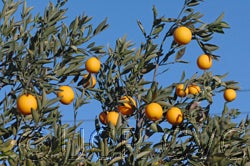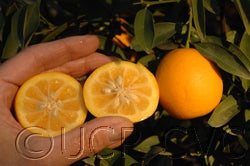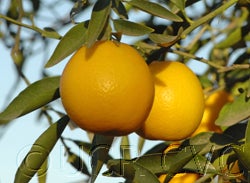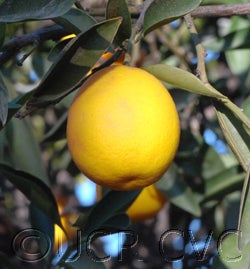X Citrofortunella sp.
CRC 4097
PI 654885
Source
Received as seed by Alfred R. Loeblich III , University of Houston, Monte Alto, Texas, 1994. The Rio Farms' tree was received as seed in 1953.
Parentage/origins
This is supposed to be a hybrid of C. limon x Fortunella sp. Current accession derived from open pollinated seed. The original seedlot produced 5 apparently identical seedlings. Two of these were planted in field for observation in 1998. The seedling was selected as being consistent with the description by Ottilia 'Toots' Bier and Robert Krueger and was retained as CRC 4097 in 2002.
Rootstocks of accession
Carrizo citrange
Season of ripeness at Riverside
Unknown
Notes and observations
E. Mortensen, 1954: (From Citrus rootstocks in the Winter Garden area of Texas. Proc, 8th Ann Rio Grande Hoort Inst, pp 13-22): 'Lemonquat is a chance hybrid found by Leslie Cude at Beeville, Texas. One tree budded on sour orange in 1942 was 8 feet tall with a 7-foot tree spread at 10 years of age. It is fairly open and thorny with flowering habits like the kumquat. Fruits are round to pyriform, ranging from 1 1/2 to 3 inches in diameter, and orange yellow when ripe. The interior of the fruit is lemon like, has a pleasant acidity, and becomes sweeter in March and April. It is highly cold resistant, and the remarkably uniform seedlings develop rapidly. Swingle considered this variety as a probable hybrid of Meyer lemon and kumquat.' The donor, A. Leoblich, hand wrote in the label: 'mostly a mandaquat not a lemonquat.'
Olson and Sleeth, 1965: 'Lemonquat' is a chance hybrid found at Beeville and tested at Crystal City, Texas...The 'lemonquat' has value for backyard culture in areas where standard lemons are injured by cold, since it has acid fruit, is cold-hardy, and blooms several times a year. It can be propagated as cuttings."
RRK, 08/2007: The fruit of this lemonquat are very similar to those of Sunquat which suggests to us that this is another mandarinquat (perhaps it has Clementine or Dancy tangerine as a parent). Circa 1981, Chapman suggested such a possibility and Mortensen agreed that the Rio Grande Valley Lemonquat could also be a mandarinquat." (Loeblich and Walden, 1993) At the time of donation, Dr Loeblich reiterated his belief that this accession is probably a "mandarinquat". Olson and Sleeth (1965) recommend as a rootstock 'Cleopatra' mandarin or calamondin.
Availability
Not commercially available in California.
USDA Germplasm Resources Information Network page for Rio Grande Valley Lemonquat
Bibiography
Loeblich, AR, and LG Walden. 1993. The "peel-icious" sunquat: eat it whole. Fruit Gardener, 25(6):2,3,10-12.
Mortensen, E. 1954. Citrus rootstocks in the Winter Garden area of Texas. Proc, 8th Ann Rio Grande Valley Hort Inst, pp 13-22.
Olson, E, N Maxwell, and AV Shull. 1961. Citrus species, varieties and hybrids in Texas. Texas A&M/Texas AES Publication MP-549.
Olson, EO, and M Sleeth. 1965. Release to Texas growers of budwood of virus-indexed selections of 11 varieties. J Rio Grande Valley Hort Soc, pp 17-19.



